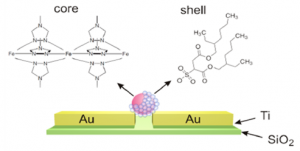Nanoparticles

Although single molecules offer the advantage of ultimate small scale and quantization effects, some magnetic properties, such as magnetic ordering or (light-induced) structural phase transitions, are associated with bulk compounds. In recent years the advances in synthetic coordination chemistry have yielded a new class of molecular magnetic materials: coordination nanoparticles. With sizes in the order of 3-10 nm, these objects are suitable for use in nanoelectronic devices and at the same time still possess the useful properties of the original material. To connect these nanoparticles to electrodes, we employ nanometer spaced trenches which are fabricated with a self-aligned fabrication process. The trench length can be varied from 20 nm up to the micron scale: The narrow devices can be used to contact a single particle whereas in the wider samples several particles are placed in parallel. The device geometry offers great stability even at room temperature and can also be used to concentrate optical fields inside the trench.
We have used these self-aligned gaps to measure spin-crossover nanoparticles. This nanoscale device exhibits switching and memory effects near room temperature as a consequence of the intrinsic instability of the spin-crossover nanoparticle. A sharp increase in the conductance is observed upon heating above 350 K, together with the presence of a thermal hysteresis as large as 50 K after which the conductance switches back to the original value. Interestingly for molecular spintronics, the spin crossover can also be induced by applying a voltage, showing that its magnetic state is controllable electrically.
Interaction with light in these trenches has been studied with inorganic PbSe nanoparticles (also called colloidal quantum dots), which directly bridge the nanometer-spaced electrodes. Unlike in conventional quantum-dot thin film photodetectors, charge mobility no longer plays a role in this device as charge extraction requires only two individual tunnel events. We find an efficient photoconductive gain mechanism with external quantum-efficiencies of 38 electrons-per-photon in combination with response times faster than 300 ns.
Room-temperature electrical addressing of a bistable spin-crossover molecular system
F. Prins, M. Monrabel-Capilla, E.A. Osorio, E. Coronado and H.S.J. van der Zant
Adv. Mat. 23 (2011) 1545
Fast and efficient photodetection in nanoscale quantum-dot junctions
F. Prins et al., submitted
